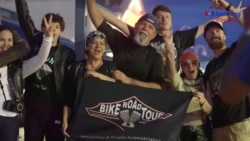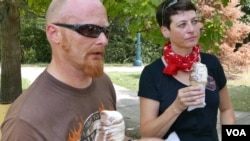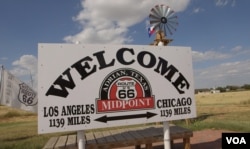Shamrock, Texas is a small town 30 kilometers from the Oklahoma-Texas border. The nearest major international airport is some 140 kilometers away. Some might say it is “in the middle of nowhere.”
And yet, every year, Shamrock welcomes nearly 15,000 international visitors. What draws so many to this Texas town of 2,000 people? Route 66, the Main Street of America.
Most roads are used to get from point A to point B. But Route 66 is different.
Many decades ago, Route 66 travelers who passed through Shamrock were on their way west, seeking more opportunity and a better life.
For today’s travelers who make the long drive from Chicago to Los Angeles, the road itself is the attraction.
Route 66, often called the Mother Road, is known worldwide. And every year, thousands of international visitors come to see what makes it so special. You see them traveling in large groups on motorcycles or buses. You see them traveling in small groups, at a slower pace, in a car or recreational vehicle.
Diane Clonts works at the U-Drop Inn in Shamrock. The Art Deco-style inn began hosting travelers in the 1930s. Today, it is a friendly visitor’s center and a place for travelers to talk and enjoy some coffee before hitting the road again.
The center displays photographs from Route 66’s early period, and vintage clothing for visitors to try on. On its wall hangs a world map with hundreds of pushpins. Each one represents an overseas visitor.
“They're from all over. We have many Europeans, we have people from Russia. We have a lot of Australians...The appeal for many, they tell me, is that when you've lived in a country where there are borders, and you can not freely go from state to state, country to country, like we can, the appeal is the amazing openness of getting on Route 66 and going from Chicago to Santa Monica, California. They love the beauty as well as the freedom.”
The freedom of the open road is what draws the large motorcycle groups from countries as far as Switzerland, Germany and Brazil. Certainly, they could go faster on the newer interstate highways. But this journey is not about speed.
From Illinois to Texas to California, and all of the places in between, international visitors who travel the Mother Road get a taste of small-town America. They experience a way of life far removed from the bright lights of New York and Miami, the two most popular destinations for foreign visitors to the U.S.
In Joliet, Illinois, about an hour outside of Chicago, a Swiss motorcycle group was at the very beginning of its Route 66 adventure. The bikers stopped to enjoy an ice cream cone at Rich and Creamy. It is a kitschy roadside sweet shop, with a large green and pink sign that reads “Joliet: Kicks on 66.”
The 30 bikers in the motorcycle tour group had flown to Chicago from Europe. They rented Harley-Davidson motorcycles in Chicago, and planned to take three weeks to travel to LA, the end of Route 66.
One of the bikers said that, for them, taking a motorcycle along Route 66 is just “something you hear about and want to do.”
After some ice cream and a few stops at other roadside attractions, the group fueled up at Nelly’s Diner in nearby Wilmington. In recent years, the diner has become a favorite lunch place for international visitors.
Flags from around the world hang in the cozy restaurant, which mostly offers hamburgers and other sandwiches. People from all over have written their names and messages in dozens of languages on Nelly's walls.
Though it is a little stressful, the cooks and servers have become experts at quickly feeding big groups of hungry bikers all at once.
These days, foreign tourists far outnumber American tourists along Route 66.
Melba Rigg sees that every year, at her souvenir shop in Galena, Kansas. For the six months of the year that Cars on the Route is open, Melba meets and greets some 5,000 overseas visitors. In that same period, about 1,000 U.S. visitors stop at the store.
Melba and others along Route 66 say the appeal of the road is only growing.
Fran Houser runs a business at the geographical midpoint of the Mother Road, in Adrian, Texas. While most of her visitors are from Europe, she says more tourists from Asia, Australia, and South America are coming each year.
“We are seeing this year tons of people from China, which we had not seen a few years ago. We see them from Japan, New Zealand…it’s all over the world. And it is wonderfully gratifying.”
International visitors along Route 66 leave their mark – literally! Not far from the road’s midpoint in Texas is Cadillac Ranch. It is one of the most famous – and visible – roadside attractions of them all.
Ten old Cadillac cars rise, half-buried, from the ground. Their classic tailfins point to the wide Texas sky. The art installation is meant to represent the golden age of cars – a period of history when Route 66 thrived.
The site attracts plenty of tourists, many of whom come with a can of spray paint. Visitors are permitted to paint the cars.
Susana was visiting Cadillac Ranch from Spain. She rented a car in Los Angeles and was on her way to Chicago via Route 66. At Cadillac Ranch, she wrote her name on one of the old cars before continuing her travels.
“Well, we actually love it. We saw it on pictures, on Internet before, so we said, like, ‘we have to stop here.’ It's really nice.”
The Route 66 journey is one that many people around the world have long dreamed of.
Ednilson Gablak was at the end of that journey. He and 15 other bikers from Brazil enjoyed the final moments of their Route 66 experience at the Santa Monica Pier, where the Mother Road meets the Pacific Ocean.
"We just finish(ed) our dream trip. We start(ed), like 15 days ago. Well, it's kind of a dream. We saw movies; we saw on the television, magazines, saw photos. Today, we can see (on) the Internet so many videos. So I think everybody knows something about Route 66, right?"
I’m Caty Weaver.
And I’m Ashley Thompson.
Ashley Thompson and Caty Weaver wrote this story for VOA Learning English. Hai Do was the editor. Adam Brock was the videographer.
______________________________________________________________
Words in This Story
recreational vehicle - n. a large vehicle that often has a bathroom, kitchen, and beds for use during travel and camping
kitschy - adj. describing things (such as movies or works of art) that are of low quality and that many people find amusing and enjoyable
diner - n. a small, informal, and inexpensive restaurant
cozy - adj. small, comfortable, and warm
fuel up - phrasal verb/idiomatic. (in this usage) to eat
souvenir - n. something that is kept as a reminder of a place you have visited, an event you have been to, etc.













